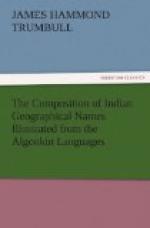* * * * *
Of names of the first class, in central and southern New England, some of the more common substantival components or ‘ground-words’ are those which denote Land or Country, River, Water, Lake or Pond, Fishing-place, Rock, Mountain, Inclosure, and Island.
1. The Massachusetts OHKE (Narr. auke; Delaware, hacki; Chip. ahke; Abnaki, ’ki;) signifies LAND, and in local names, PLACE or COUNTRY. The final vowel is sometimes lost in composition. With the locative suffix, it becomes ohkit (Del. hacking; Chip. ahki[n]; Abn. kik;) at or in a place or country.
To the Narragansetts proper, the country east of Narragansett Bay and Providence River was wa[n]pan-auke, ‘east land;’ and its people were called by the Dutch explorers, Wapenokis, and by the English, Wampanoags. The tribes of the upper St. Lawrence taught the French, and tribes south of the Piscataqua taught the English, to give the name of East-landers—Abenaquis, or Abinakis—to the Indians of Maine. The country of the Delawares was ‘east land,’ Wapanachki, to Algonkin nations of the west.
The ‘Chawwonock,’ or ‘Chawonocke,’ of Capt. John Smith,—on what is now known as Chowan River, in Virginia and North Carolina,—was, to the Powhattans and other Virginian tribes, the ‘south country,’ or sowan-ohke, as Eliot wrote it, in Gen. xxiv. 62.
With the adjectival sucki, ‘dark-colored,’ ‘blackish,’ we have the aboriginal name of the South Meadow in Hartford,—sucki-ohke, (written Sicaiook, Suckiaug, &c.), ‘black earth.’
Wuskowhanan-auk-it, ‘at the pigeon country,’ was the name (as given by Roger Williams) of a “place where these fowl breed abundantly,”—in the northern part of the Nipmuck country (now in Worcester county, Mass.).
‘Kiskatamenakook,’ the name of a brook (but originally, of some locality near the brook) in Catskill, N.Y.,[5] is kiskato-minak-auke, ‘place of thin-shelled nuts’ (or shag-bark hickory nuts).
[Footnote 5: Doc. Hist. of New York (4to), vol. iii. p. 656.]
2. RIVER. Seip or sepu (Del. sipo; Chip. s[=e]p[=e]; Abn. sip[oo];) the Algonkin word for ‘river’ is derived from a root that means ‘stretched out,’ ‘extended,’ ‘become long,’ and corresponds nearly to the English ‘stream.’ This word rarely, if ever, enters into the composition of local names, and, so far as I know, it does not make a part of the name of any river in New England. Mississippi is missi-sipu, ‘great river;’ Kitchi-sipi, ‘chief river’ or ’greatest river,’ was the Montagnais name of the St. Lawrence;[6] and Miste-shipu is their modern name for the Moise or ‘Great River’ which flows from the lakes of the Labrador peninsula into the Gulf of St. Lawrence.[7]




